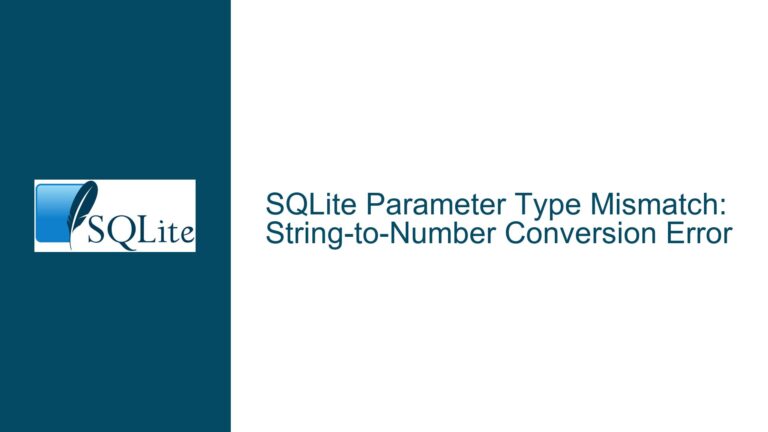SQLite Operator Behavior Change: Numeric Conversion in String Operations
Numeric Conversion Behavior in SQLite Versions 3.22.0 vs. 3.31.1
The behavior of numeric conversion in SQLite has undergone a subtle but significant change between versions 3.22.0 and 3.31.1, particularly when performing arithmetic operations on strings that contain numeric prefixes. In SQLite 3.22.0, the operation SELECT '1.txt' + 1; yields the integer result 2, whereas in SQLite 3.31.1, the same operation yields the floating-point result 2.0. This change in behavior is not a bug but rather an intentional modification in how SQLite handles string-to-numeric conversions during arithmetic operations. Understanding this change requires a deep dive into SQLite’s type affinity system, its handling of string literals, and the evolution of its internal logic for numeric conversions.
In SQLite, type affinity plays a crucial role in determining how values are treated during operations. When a string literal such as '1.txt' is involved in an arithmetic operation, SQLite attempts to convert the string to a numeric value based on its content. Prior to version 3.29.0, SQLite would only convert the initial numeric part of the string up to the first non-numeric character, treating '1.txt' as the integer 1. However, starting with version 3.29.0, SQLite’s conversion logic was refined to recognize floating-point representations within strings. As a result, '1.txt' is now interpreted as the floating-point value 1.0 because the period (.) is recognized as a valid part of a floating-point number.
This change in behavior is rooted in SQLite’s commitment to improving consistency and predictability in its handling of mixed-type operations. The modification ensures that strings containing floating-point representations are treated more accurately, aligning SQLite’s behavior with user expectations and reducing the likelihood of unexpected results. However, this change can lead to confusion for users who rely on the older behavior, particularly in applications where string manipulation and arithmetic operations are tightly coupled.
Interrupted String-to-Numeric Conversion Logic in Arithmetic Operations
The change in SQLite’s behavior can be attributed to an intentional adjustment in how the database engine processes string literals during arithmetic operations. In earlier versions, SQLite’s conversion logic was more simplistic, focusing solely on extracting integer values from strings. This approach worked well for many use cases but could lead to inconsistencies when dealing with strings that contained floating-point representations or other non-integer numeric formats.
In SQLite 3.22.0, the operation SELECT '1.txt' + 1; would first convert the string '1.txt' to the integer 1 by extracting the initial numeric characters and ignoring the rest. The addition operation would then proceed with the integer values, resulting in the integer 2. This behavior was consistent with SQLite’s type affinity rules at the time, which prioritized integer conversion for strings in arithmetic contexts.
However, this approach had limitations. For example, strings like '1.5abc' would be truncated to 1, losing the fractional component and potentially leading to inaccurate results. To address this, SQLite’s developers introduced a more sophisticated conversion logic in version 3.29.0. This new logic recognizes floating-point representations within strings, allowing values like '1.txt' to be interpreted as 1.0 instead of 1. As a result, the operation SELECT '1.txt' + 1; now yields the floating-point result 2.0, reflecting the improved accuracy of the conversion process.
The change in behavior is also evident in the EXPLAIN output for the query. In SQLite 3.22.0, the EXPLAIN output for SELECT '1.txt' + 1; shows a straightforward sequence of operations: the string '1.txt' is loaded, the integer 1 is loaded, and the Add opcode performs the addition. In SQLite 3.31.1, the EXPLAIN output may include additional steps to handle the floating-point conversion, reflecting the enhanced logic introduced in version 3.29.0.
Implementing Type Casting and Version-Specific Workarounds
To address the change in behavior and ensure consistent results across different versions of SQLite, users can implement several strategies. One approach is to explicitly cast string literals to the desired numeric type using the CAST function. For example, the query SELECT CAST('1.txt' AS INTEGER) + 1; will yield the integer result 2 in all versions of SQLite, as the CAST function ensures that the string is converted to an integer before the addition operation.
Another strategy is to use version-specific logic in applications that rely on the older behavior. By checking the version of SQLite at runtime, applications can adjust their queries accordingly. For example, if the application detects that it is running on SQLite 3.29.0 or later, it can use the CAST function to enforce integer conversion. If the application is running on an earlier version, it can rely on the default behavior.
Additionally, users can leverage SQLite’s PRAGMA statements to control certain aspects of its behavior. For example, the PRAGMA legacy_file_format setting can influence how SQLite handles certain operations, although it does not directly affect the string-to-numeric conversion logic. Users should consult the SQLite documentation to identify relevant PRAGMA statements and their effects.
For applications that require precise control over numeric conversions, it may be beneficial to implement custom functions or extensions. SQLite’s extensibility allows users to define their own functions in C or other programming languages, providing a way to enforce specific conversion rules. For example, a custom function could be designed to extract only the integer portion of a string, mimicking the behavior of SQLite 3.22.0.
Finally, users should consider the broader implications of the change in behavior for their applications. While the modification improves accuracy and consistency, it may also introduce subtle differences in query results, particularly in applications that perform complex string manipulations or rely on specific numeric formats. Thorough testing and validation are essential to ensure that applications continue to function as expected after upgrading to a newer version of SQLite.
In conclusion, the change in SQLite’s string-to-numeric conversion logic between versions 3.22.0 and 3.31.1 reflects an intentional effort to improve the accuracy and consistency of arithmetic operations involving string literals. While this change may require adjustments in some applications, it ultimately enhances SQLite’s reliability and predictability. By understanding the underlying mechanisms and implementing appropriate strategies, users can effectively manage the transition and ensure consistent results across different versions of SQLite.






